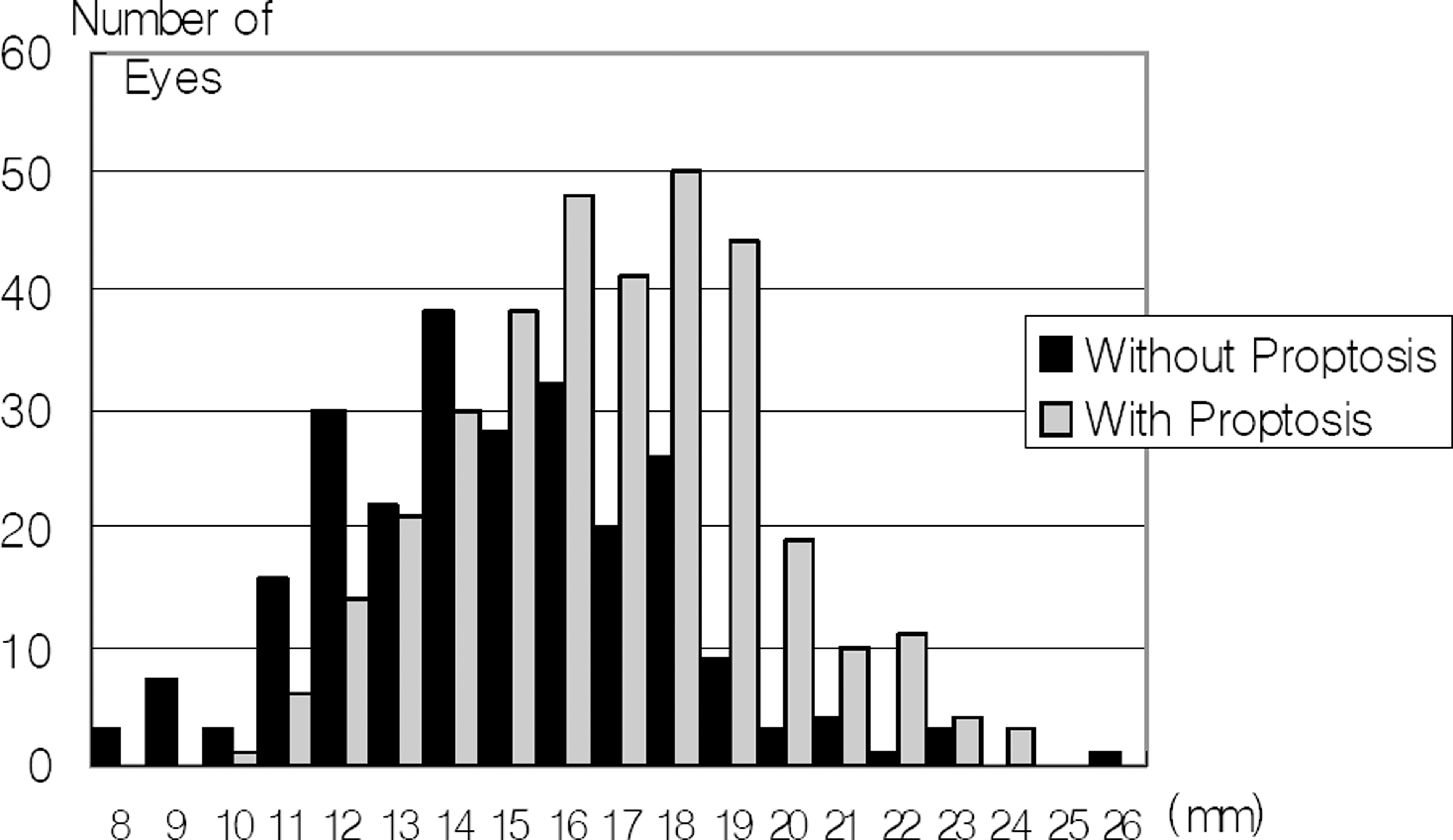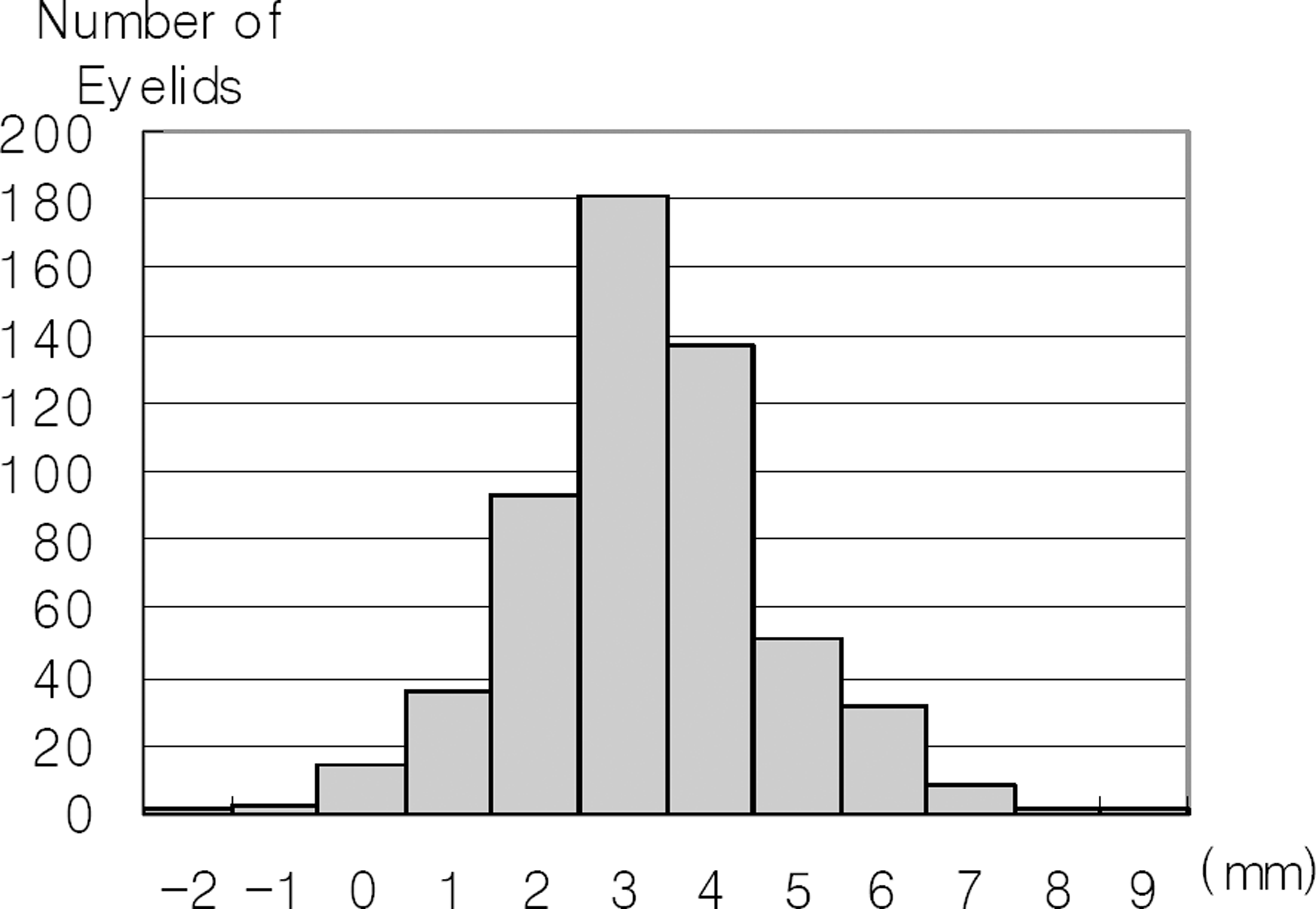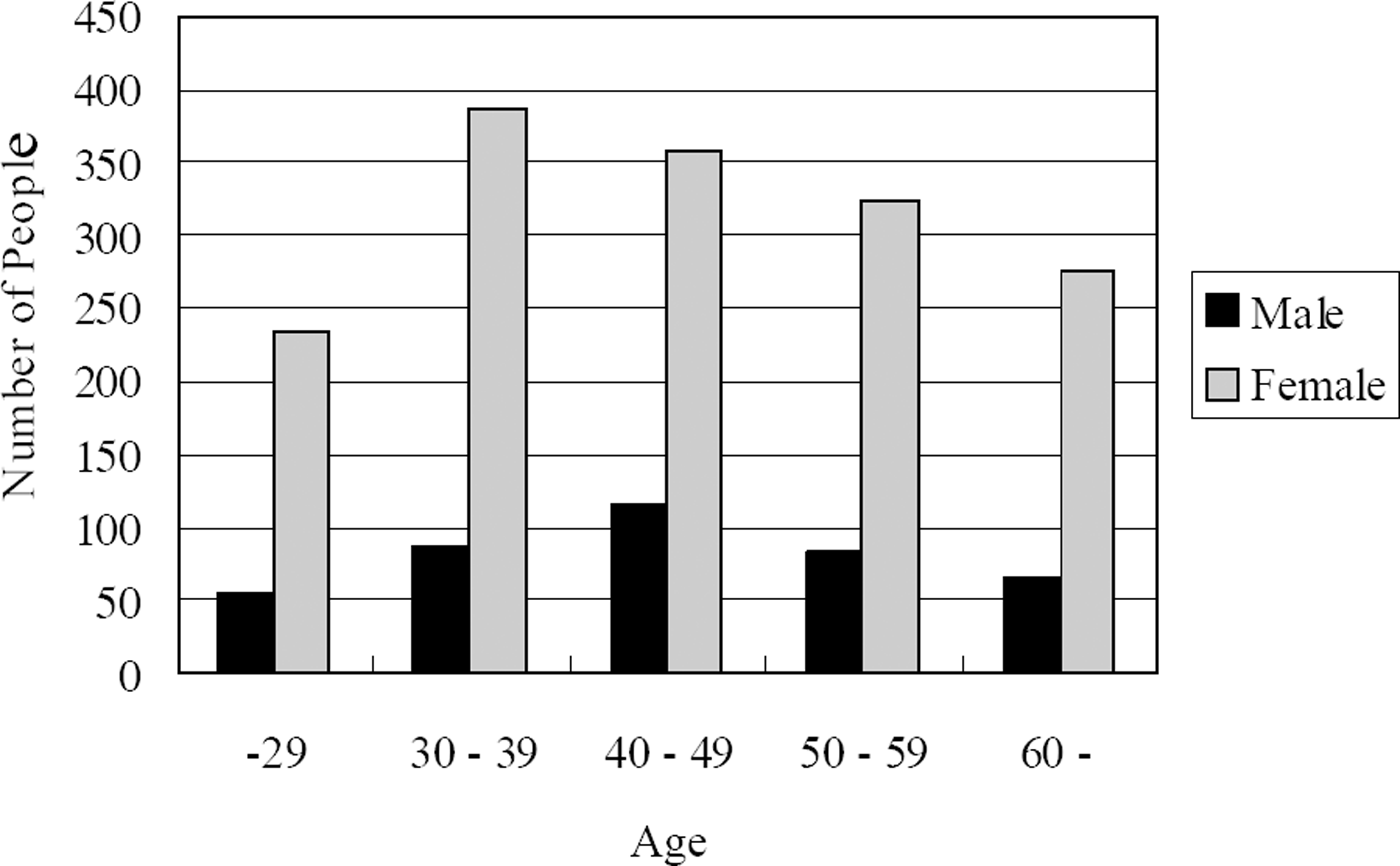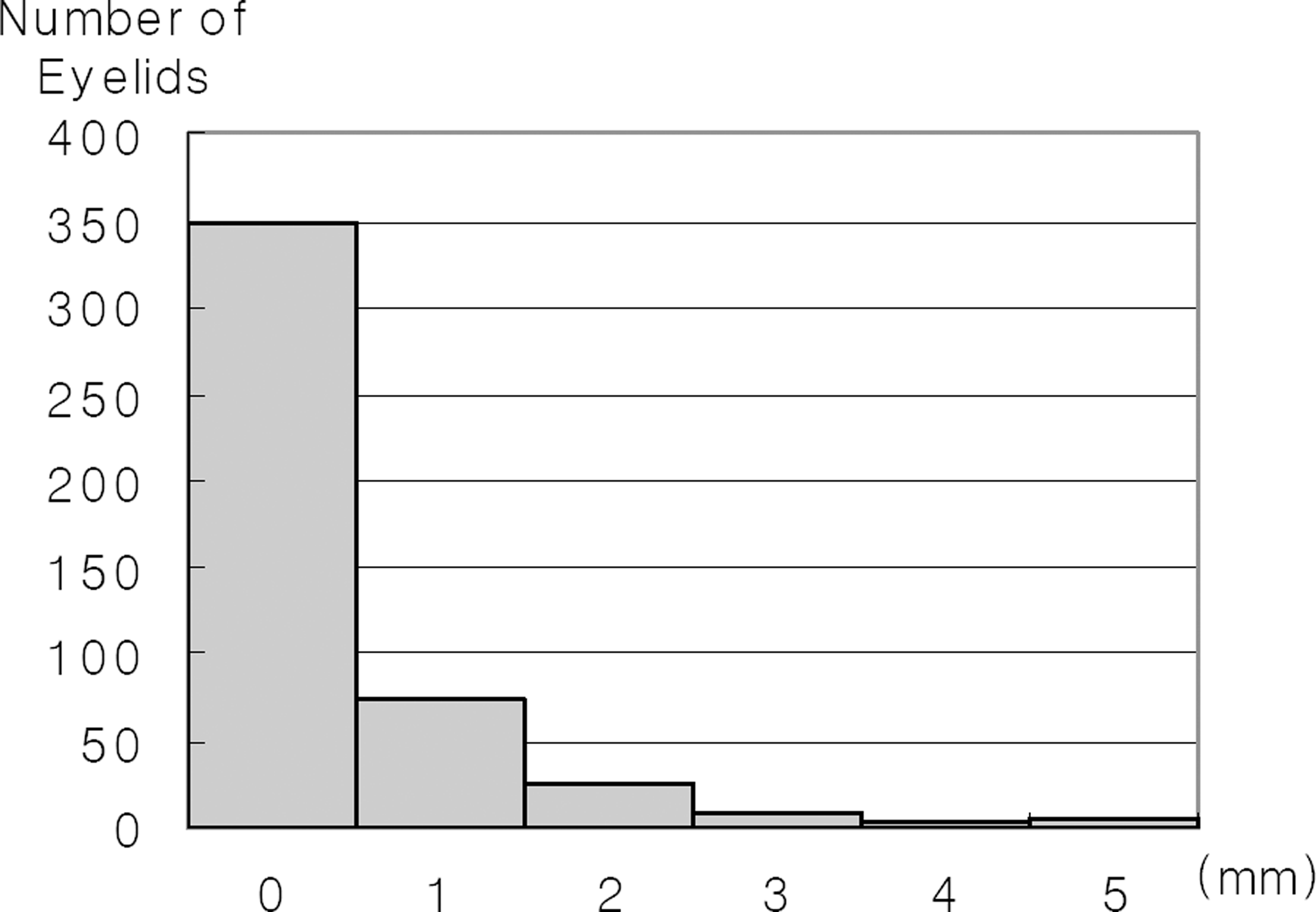Abstract
Purpose
To investigate the clinical manifestation of thyroid orbitopathy among patients with thyroid dysfunction.
Methods
A cross-sectional study was conducted at 24 general hospitals in Korea. All dysthyroid patients who visited the endocrinology clinic for 1 week were included. Data were collected during an interviewer- administered questionnaire. Thyroid orbitopathy was diagnosed in cases with relevant symptoms according to the VISA classification for which an eye examination was performed. Three hundred seventy-one patients who had thyroid orbitopathy out of 1986 dysthyroid patients were evaluated.
Results
Vision symptoms were presented in 10.5% of thyroid orbitopathy patients, inflammation symptoms in 43.1%, strabismus in 15.1%, and appearance and exposure symptoms in 86.3% of patients. Among the eye symptoms, proptosis was most prevalent in 56.9% of patients followed by eyelid retraction in 31.5%, diplopia in 15.1% and optic nerve dysfunction in 2.4% of patients. Median value of exophthalmometry in the thyroid orbitopathy group was 16 mm and 17 mm in the proptosis group. Patient self assessment for thyroid orbitopathy from the onset of the disease was "greatly improved" in 12.1% of patients, "improved" in 19.5%, "unchanged" in 51.2%, "worse" in 19.6%, and "much worse" in 1.0% of patients.
Go to : 
References
1. Diez JJ, Molina I, Ibars MT. Prevalence of thyroid dysfunction in adults over age 60 years from an urban community. Exp Clin Endocrinol Diabetes. 2003; 111:480–5.

2. Empson M, Flood V, Ma G. . Prevalence of thyroid disease in an older Australian population. Intern Med J. 2007; 37:448–55.

3. Bartley GB, Fatourechi V, Kadrmas EF. . The incidence of Graves' ophthalmopathy in Olmsted County, Minnesota. Am J Ophthalmol. 1995; 120:511–7.

4. Rootman J. Diseases of the orbit: a multidisciplinary approach. 2nd. Philadelphia: Lippincott Williams & Wilkins;2003. p. 173–89.
5. Wiersinga WM, Bartalena L. Epidemiology and prevention of Graves' ophthalmopathy. Thyroid. 2002; 12:855–60.

6. Donaldson LJ, Taylor JB. Patterns of Asian and non-Asian morbidity in hospitals. Br Med J (Clin Res Ed). 1983; 286:949–51.

7. Tsai CC, Kau HC, Kao SC, Hsu WM. Exophthalmos of patients with Graves' disease in Chinese of Taiwan. Eye. 2006; 20:569–73.

8. Tellez M, Cooper J, Edmonds C. Graves' ophthalmopathy in relation to cigarette smoking and ethnic origin. Clin Endocrinol (Oxf). 1992; 36:291–4.

9. Manji N, Carr-Smith JD, Boelaert K. . Influences of age, gender, smoking, and family history on autoimmune thyroid disease phenotype. J Clin Endocrinol Metab. 2006; 91:4873–80.

10. Perros P, Crombie AL, Matthews JN, Kendall-Taylor P. Age and gender influence the severity of thyroid-associated ophthalmopathy: a study of 101 patients attending a combined thyroid-eye clinic. Clin Endocrinol (Oxf). 1993; 38:367–72.

11. Bartalena L. Marcocci C, TandamMi, et al. Cigarette smoking and treatment outcomes in Graves ophthalmopathy. Ann Internal Med. 1998; 129:632–5.
12. Eckstein A, Quadbeck B, Mueller G. . Impact of smoking on the response to treatment of thyroid associated ophthalmopathy. Br J Ophthalmol. 2003; 87:773–6.

13. Mann K. Risk of smoking in thyroid-associated orbitopathy. Exp Clin Endocrinol Diabetes. 1999; 107:S164–7.

14. Yoshiuchi K, Kumano H, Nomura S. . Stressful life events and smoking were associated with Graves' disease in women, but not in men. Psychosom Med. 1998; 60:182–5.

15. Prahalad S, Shear ES, Thompson SD. . Increased prevalence of familial autoimmunity in simplex and multiplex families with juvenile rheumatoid arthritis. Arthritis Rheum. 2002; 46:1851–6.

16. Benhaim Rochester D, Davies TF. Increased risk of Graves' disease after pregnancy. Thyroid. 2005; 15:1287–1290.

17. Cho HJ, Song YM, Smith GD, Ebrahim S. Trends in socio-economic differentials in cigarette smoking behaviour between 1990 and 1998: a large prospective study in Korean men. Public Health. 2004; 118:553–8.

18. Chung MH, Chung KK, Chung CS, Raymond JS. Health-related behaviors in Korea: smoking, drinking, and perinatal care. Asia Pac J Public Health. 1992; 6:10–5.

19. Centers for Disease Control and Prevention (CDC) Prevalence of cigarette use among 14 racial/ethnic populations-United States 1999-2001. Morbidity and mortality weekly report. MMWR Morb Mortal Wkly Rep. 2004; 53:49–52.
20. Dolman PJ, Rootman J. VISA Classification for Graves orbitopathy. Ophthal Plast Reconstr Surg. 2006; 22:319–24.

21. Mourits MP, Prummel MF, Wiersinga WM, Koornneef L. Clinical activity score as a guide in the management of patients with Graves' ophthalmopathy. Clin Endocrinol (Oxf). 1997; 47:9–14.

22. Mourits MP, Koornneef L, Wiersinga WM. . Clinical criteria for the assessment of disease activity in Graves' ophthalmopathy: a novel approach. Br J Ophthalmol. 1989; 73:639–44.

23. Prummel MF, Wiersinga WM, Mourits MP. . Effect of abnormal thyroid function on the severity of Graves' ophthalmopathy. Arch Intern Med. 1990; 150:1098–101.

24. Utiger RD, Braverman LE. Werner & Ingbar's the thyroid : a fundamental and clinical text. 8th. Philadelphia: Lippincott-Raven;2000. 688:p. 851.
25. Forbes G, Gorman CA, Brennan MD. . Ophthalmopathy of Graves' disease: computerized volume measurements of the orbital fat and muscle. AJNR Am J Neuroradiol. 1986; 7:651–6.
26. Werner SC, Coleman DJ, Franzen LA. Ultrasonographic evidence of a consistent orbital involvement in Graves's disease. N Engl J Med. 1974; 290:1447–50.

27. Streeten DH, Anderson GH, Jr., Reed GF, Woo P. Prevalence, natural history and surgical treatment of exophthalmos. Clin Endocrinol (Oxf). 1987; 27:125–33.

28. Werner SC. Classification of the eye changes of Grave's disease. J Clin Endocrinol Metab. 1969; 29:982–4.

29. Bartley GB, Fatourechi V, Kadrmas EF. . Chronology of Graves' ophthalmopathy in an incidence cohort. Am J Ophthalmol. 1996; 121:426–34.
30. Wiersinga WM, Smit T, van der Gaag R, Koornneef L. Temporal relationship between onset of Graves' ophthalmopathy and onset of thyroidal Graves' disease. J Endocrinol Invest. 1988; 11:615–9.

31. Rhee KC, Lee TS. The clinical study on Graves' ophthalmopathy. J Korean Ophthalmol Soc. 1999; 40:2923–7.
32. Rhim WI, Choi SS, Lew H, Yun YS. Correlation between the thyroid associated ophthalmopathy and thyroid function state. J Korean Ophthalmol Soc. 2002; 43:431–6.
33. Bartley GB, Fatourechi V, Kadrmas EF. . Clinical features of Graves' ophthalmopathy in an incidence cohort. Am J Ophthalmol. 1996; 121:284–90.

34. Frueh BR. Graves' eye disease: orbital compliance and other physical measurements. Trans Am Ophthalmol Soc. 1984; 82:492–598.
35. Sridama V, DeGroot LJ. Treatment of Graves' disease and the course of ophthalmopathy. Am J Med. 1989; 87:70–3.

Go to : 
 | Figure 2.Distribution of total exophthalmometric values of thyroid orbitopathy (586 eyes of 298 patients). It shows the number of eyes in each value of the patients without proptosis and with proptosis. |
 | Figure 3.Distribution of the margin-reflex distance (MRD1) of the upper eyelids in thyroid orbitopathy patients. (558 eyes of 279 patients) |
Table 1.
Characteristics of dysthyroid patients
| Characteristics | N/Mean±S.D | (%) |
|---|---|---|
| Study population | 1,986 | |
| Sex (M/F) | 406/1580 | |
| Mean age±S.D. | 45.1±14.0 | |
| Duration of thyroid disease (Mean±S.D.) | 49.0±58.2 | |
| Family history of thyroid disease | 449/1,965 | 22.6 |
| Ever smoker | 325/1,931 | 16.8 |
| Current smoker | 176/1,931 | 9.1 |
| Dermopathy | 28/1,634 | 1.7 |
| Thyroid function test at initial presentation (N=1,743) | ||
| Hyper∗ | 852 | 48.9 |
| Subclinical hyper | 172 | 9.9 |
| Euthyroid | 217 | 12.4 |
| Subclinical hypo† | 203 | 11.6 |
| Hypo | 173 | 9.9 |
| Others | 126 | 7.2 |
| Thyroid function test nearest to study (N=1,674) | ||
| Hyper | 214 | 12.7 |
| Subclinical hyper | 262 | 15.7 |
| Euthyroid | 726 | 43.4 |
| Subclinical hypo | 234 | 14.0 |
| Hypo | 87 | 5.2 |
| Others | 151 | 9.0 |
| Treatments for thyroid dysfunction | ||
| Antithyroid medication | 1045 | 58.8 |
| Thyroidectomy | 34 | 1.9 |
| Radioiodine | 88 | 4.9 |
| Thyroid hormone | 611 | 34.4 |
Table 2.
Characteristics of patients with thyroid orbitopathy (N=371)
Table 3.
Manifestations of thyroid orbitopathy (N=371)
Table 4.
Distribution of Clinical Activity Score among thyroid orbitopathy patients
| CAS∗ | Patients |
|---|---|
| 0 | 105 (29.8%) |
| 1 | 128 (36.3%) |
| 2 | 78 (22.1%) |
| 3 | 16 (4.5%) |
| 4 | 17 (4.8%) |
| 5 | 4 (1.1%) |
| 6 | 3 (0.9%) |
| 7 | 2 (0.6%) |
| Total | 353 (100%) |
Table 5.
Patient self assessment score




 PDF
PDF ePub
ePub Citation
Citation Print
Print




 XML Download
XML Download